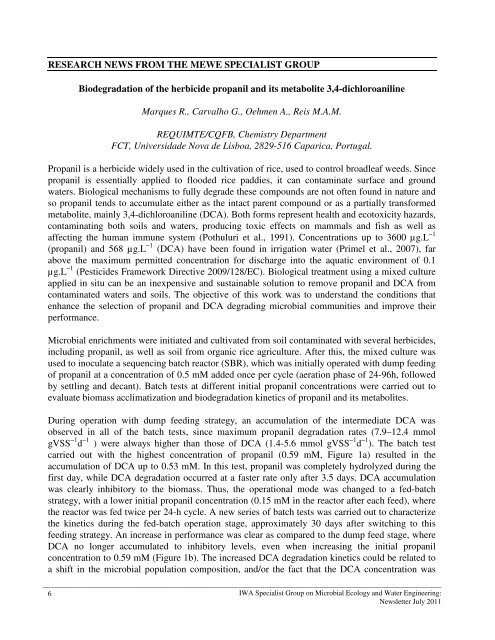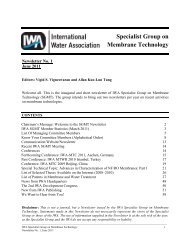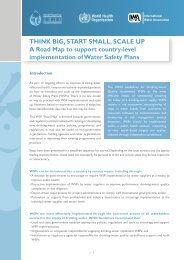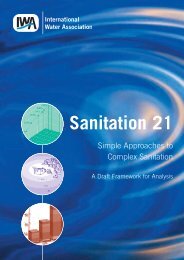Specialist Group on Microbial Ecology and Water Engineering - IWA
Specialist Group on Microbial Ecology and Water Engineering - IWA
Specialist Group on Microbial Ecology and Water Engineering - IWA
- No tags were found...
You also want an ePaper? Increase the reach of your titles
YUMPU automatically turns print PDFs into web optimized ePapers that Google loves.
RESEARCH NEWS FROM THE MEWE SPECIALIST GROUPBiodegradati<strong>on</strong> of the herbicide propanil <strong>and</strong> its metabolite 3,4-dichloroanilineMarques R., Carvalho G., Oehmen A., Reis M.A.M.REQUIMTE/CQFB, Chemistry DepartmentFCT, Universidade Nova de Lisboa, 2829-516 Caparica, Portugal.Propanil is a herbicide widely used in the cultivati<strong>on</strong> of rice, used to c<strong>on</strong>trol broadleaf weeds. Sincepropanil is essentially applied to flooded rice paddies, it can c<strong>on</strong>taminate surface <strong>and</strong> groundwaters. Biological mechanisms to fully degrade these compounds are not often found in nature <strong>and</strong>so propanil tends to accumulate either as the intact parent compound or as a partially transformedmetabolite, mainly 3,4-dichloroaniline (DCA). Both forms represent health <strong>and</strong> ecotoxicity hazards,c<strong>on</strong>taminating both soils <strong>and</strong> waters, producing toxic effects <strong>on</strong> mammals <strong>and</strong> fish as well asaffecting the human immune system (Pothuluri et al., 1991). C<strong>on</strong>centrati<strong>on</strong>s up to 3600 µg.L −1(propanil) <strong>and</strong> 568 µg.L −1 (DCA) have been found in irrigati<strong>on</strong> water (Primel et al., 2007), farabove the maximum permitted c<strong>on</strong>centrati<strong>on</strong> for discharge into the aquatic envir<strong>on</strong>ment of 0.1µg.L −1 (Pesticides Framework Directive 2009/128/EC). Biological treatment using a mixed cultureapplied in situ can be an inexpensive <strong>and</strong> sustainable soluti<strong>on</strong> to remove propanil <strong>and</strong> DCA fromc<strong>on</strong>taminated waters <strong>and</strong> soils. The objective of this work was to underst<strong>and</strong> the c<strong>on</strong>diti<strong>on</strong>s thatenhance the selecti<strong>on</strong> of propanil <strong>and</strong> DCA degrading microbial communities <strong>and</strong> improve theirperformance.<strong>Microbial</strong> enrichments were initiated <strong>and</strong> cultivated from soil c<strong>on</strong>taminated with several herbicides,including propanil, as well as soil from organic rice agriculture. After this, the mixed culture wasused to inoculate a sequencing batch reactor (SBR), which was initially operated with dump feedingof propanil at a c<strong>on</strong>centrati<strong>on</strong> of 0.5 mM added <strong>on</strong>ce per cycle (aerati<strong>on</strong> phase of 24-96h, followedby settling <strong>and</strong> decant). Batch tests at different initial propanil c<strong>on</strong>centrati<strong>on</strong>s were carried out toevaluate biomass acclimatizati<strong>on</strong> <strong>and</strong> biodegradati<strong>on</strong> kinetics of propanil <strong>and</strong> its metabolites.During operati<strong>on</strong> with dump feeding strategy, an accumulati<strong>on</strong> of the intermediate DCA wasobserved in all of the batch tests, since maximum propanil degradati<strong>on</strong> rates (7.9–12.4 mmolgVSS −1 d −1 ) were always higher than those of DCA (1.4-5.6 mmol gVSS −1 d −1 ). The batch testcarried out with the highest c<strong>on</strong>centrati<strong>on</strong> of propanil (0.59 mM, Figure 1a) resulted in theaccumulati<strong>on</strong> of DCA up to 0.53 mM. In this test, propanil was completely hydrolyzed during thefirst day, while DCA degradati<strong>on</strong> occurred at a faster rate <strong>on</strong>ly after 3.5 days. DCA accumulati<strong>on</strong>was clearly inhibitory to the biomass. Thus, the operati<strong>on</strong>al mode was changed to a fed-batchstrategy, with a lower initial propanil c<strong>on</strong>centrati<strong>on</strong> (0.15 mM in the reactor after each feed), wherethe reactor was fed twice per 24-h cycle. A new series of batch tests was carried out to characterizethe kinetics during the fed-batch operati<strong>on</strong> stage, approximately 30 days after switching to thisfeeding strategy. An increase in performance was clear as compared to the dump feed stage, whereDCA no l<strong>on</strong>ger accumulated to inhibitory levels, even when increasing the initial propanilc<strong>on</strong>centrati<strong>on</strong> to 0.59 mM (Figure 1b). The increased DCA degradati<strong>on</strong> kinetics could be related toa shift in the microbial populati<strong>on</strong> compositi<strong>on</strong>, <strong>and</strong>/or the fact that the DCA c<strong>on</strong>centrati<strong>on</strong> was____________________________________________________________________________________________________________6<strong>IWA</strong> <str<strong>on</strong>g>Specialist</str<strong>on</strong>g> <str<strong>on</strong>g>Group</str<strong>on</strong>g> <strong>on</strong> <strong>Microbial</strong> <strong>Ecology</strong> <strong>and</strong> <strong>Water</strong> <strong>Engineering</strong>:Newsletter July 2011
















